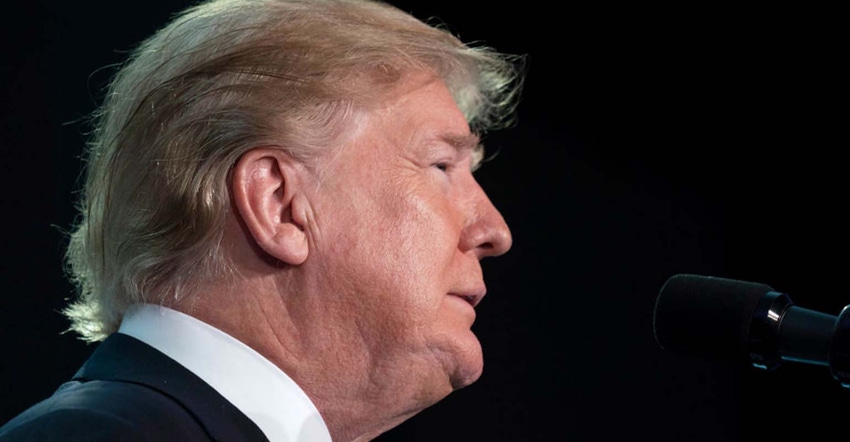
The White House rewarded farmers for their loyalty yesterday with a $12 billion support program to partially offset the negative impacts of its self-induced trade war. Who gets what and when is still in question.
The aid programs will focus on payments, purchases and trade promotion efforts, Agriculture Secretary Sonny Perdue told reporters. The secretary has $30 billion borrowing authority in the Commodity Credit Corporation(CCC), a government-owned bank used to support or stabilize farm incomes and prices, so it doesn't require approval from Congress. This will provide payments incrementally to producers of soybeans, sorghum, corn, wheat, cotton, dairy, and hogs. Additionally, USDA will use CCC and other authorities to implement a food purchase and distribution programthrough the Agricultural Marketing Service to purchase unexpected surplus of affected commodities such as fruits, nuts, rice, legumes, beef, pork and milkfor distribution to food banks and other nutrition programs.Finally, the CCC will use its Charter Act authority for a trade promotion programadministered by the Foreign Agriculture Service (FAS) in conjunction with the private sector to assist in developing new export marketsfor our farm products.
Devil in the details
The CCC was initially created to buy commodities, so theoretically the government would buy commodities to raise prices. But what then? At some point they would need to go back on the market, so price impact would be minimal. That kind of purchasing may work well for commodities that can be stored, but it won’t work well for fresh fruits and vegetables. And, it could have a negative impact in the WTO.
“There’s a lot of work that has been put into a program that would treat all the commodities in a fair, balanced way, but it clearly is a gargantuan task to help all the commodities that have been impacted,” says Dale Moore, vice president of public affairs at American Farm Bureau Federation. “I have to believe there’s a large team of economists working on a plan and trying to determine, if a farmer’s price dropped 20%, how much can be attributed to trade and how much is attributed to weather or other typical normal market fluctuations.
“It will be a challenge on how to make it bulletproof so it’s not picked apart by armchair farmers,” adds Moore, who has served as USDA chief of staff at USDA and on Capitol Hill in several positions for the House Ag Committee. Secretary Perdue said he intends for program signup to begin around Labor Day.
Support in farm country
Farm support for President Trump is still strong, but the ongoing trade war is starting to wear people down. When trade skirmishes began, rural support for the administration remained steadfast.
“They saw Trump turning up the heat on a trading partner who wasn’t playing fairly, and they believed him when he said he would protect the farmers,” says Moore.
Even so, many farmers remain anxious and conflicted when it comes to current White House policies.
“They speak admirably about President Trump ‘draining the swamp’ in Washington, reforming the tax code and making progress on regulatory relief,” says Moore. “With trade to some degree they believe the focus should be on other countries, not on President Trump. But, they also express frustration that ongoing trade battles with multiple trading partners could destroy their potential profits in an already down farm economy.”
In fact, farm support for tariffs may hinge, at least in part, on whether you forward contracted soybeans earlier this year.
“If the trade war continues through the fall, farmers and ranchers are not just going to suffer; it’s going to be a case of whether they can survive,” says Moore.
China buys most of its soybeans from Brazil in spring and summer, and historically switches to U.S. soybean imports in the fall.
For better or worse agriculture has been in the news more than any other sector in the past year. “The president has said the words ‘farmers and ranchers’ more times since the beginning of the year than any president I’ve had to work with,” says Moore. “To President Trump’s credit, I cannot remember a time in my 35 years in Washington where everyone was paying so much attention to trade.”
Faithfully following his campaign promises, President Trump pulled the U.S. from the Trans Pacific Partnership, then threatened to pull out of NAFTA before cooler heads prevailed. A deal with South Korea was a success story. An anti-dumping investigation caused the Chinese sorghum market to melt down before the Chinese abruptly dropped the case in May. This spring, steel and aluminum tariffs on both China and our closest allies brought retaliation against products grown by nearly every U.S. farmer.
Bad timing
Not everyone shares Sec. Perdue’s sense of urgency to help farmers. Director of Trade and Industrial Policy Peter Navarro, in an interview with CNBC, described the impact of the trade war with China a ‘rounding error.’ “We got two economies that add up to around $30 trillion in annual GDP. The amount of trade we’re affecting with the tariffs is a rounding error compared to that,” he said in a White House interview.
Yet, the timing of the trade war could not be worse for agriculture, as many prices recently plunged 10% to 15% in an economy already mired in a five-year slide that has seen net farm income cut in half.
“For several commodities we’re in the arena where we see prices dip below cost of production, and farmers have debts to pay,” says Moore. On the bright side, interest rates are nowhere near the levels they were in the ‘80s.
“Farmers and ranchers are as patriotic as any other group of Americans but they’re in a tough situation now, particularly young farmers, that has the potential to have a very large negative impact on their long-term viability. A lot of markets - especially China - took years to develop. It’s true China has not always been a good player in trade. We fight them on all sorts of issues. So there’s a real worry that if the tariff wars stopped tomorrow it would take years to regain those markets.”
As farmers begin harvest, Moore predicts frustration will set in, especially for producers who need to sell at harvest time. That will continue later when they meet with lenders to discuss 2019. AFBF will be consulting with banking and credit organization to explore programs that might mitigate losses from trade disruptions.
Needed: A win
Farmers may continue to support the White House, even if the trade wars drag on. They see other moves on taxes and regulation as victories for agriculture. Even so, farmers desperately need to see a win in trade, too.
“Farmers are looking for some indication there’s a landing strategy on this,” says Moore. “Getting NAFTA sorted out would be a positive step. Getting these tariff issues sorted with allies like Canada and Mexico would be another step. There are a number of trade agreement opportunities out there that would send a positive signal that the president is not rehashing the old agreements, but is actually moving ahead on new ones.”
On the campaign trail, candidate Trump championed bilateral agreements. So far, the South Korean deal is the only new agreement this administration has secured. The European Union and Japan inked a deal last week, to trade without tariffs. The White House has hinted it may re-engage with the Trans Pacific Partnership, but until then Australia, Brunei, Canada, Chile, Japan, Malaysia, Mexico, New Zealand, Peru, Singapore and Vietnam are forming a new trade deal that represents 13.4% of the global gross domestic product, or $13.5 trillion. A month ago the president sent a team to China; they came back with an agreement that China would start buying more ag imports. But before they were back and over the jet lag, the president tweeted he would slap more tariffs on China, and the deal evaporated.
About the Author(s)
You May Also Like






